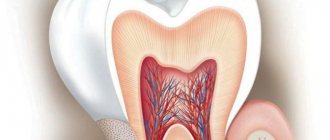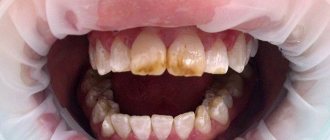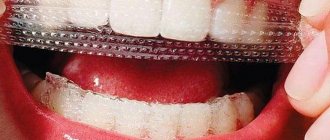What it is?
The essence of the procedure is preliminary cleaning of the oral cavity with alternate treatment with the first and second composition
The progressive demineralization of tooth enamel from the aggressive action of acids and the development of caries can be protected by using deep fluoridation.
To carry out the procedure, it is recommended to use enamel sealing liquid, which contains a strong mineral complex and has an effective restorative effect.
When applying the product to the surface of the teeth, the active components of the first composition penetrate into the pores, filling the voids, and the substances of the second fix the achieved result by sealing.
The essence of the procedure is preliminary cleaning of the oral cavity (teeth and mucosal surface) with alternate treatment with the first and second composition.
Fluoride, when combined with highly dispersed calcium hydroxide, provides deep fluoridation of the enamel structure, that is, it makes the tissue of the tooth neck hard. The session ends with mouth rinsing.
What is enamel fluoridation?
Fluoridation is one of the methods of tooth remineralization, which involves saturating the enamel with fluoride particles.
The beneficial properties of fluorides were first discussed in 1940, when the American scientist Basil Bibby managed to prove that fluoride helps restore and maintain the normal structure of the dentin and enamel layer, prevent the development of caries and other dental diseases, increase the resistance of teeth to harmful factors and slow down the process of destruction enamel.?
These days, fluoridation can be done in most dental clinics around the world. At the same time, artificial enrichment of tooth enamel with fluoride can be both superficial and deep.
Indications for use
The sealing composition is recommended for use for the following purposes:
- The deep fluoridation procedure is prescribed after removal of braces and a large accumulation of yellow plaque near the gums
to prevent the development of caries and treat lesions;
- when carrying out mineralization of fissures;
- for the prevention of other (non-carious) lesions of the enamel structure;
- to reduce the sensitivity of the neck of the tooth;
- after teeth whitening.
The deep fluoridation procedure is prescribed after the removal of braces, a large accumulation of yellow plaque near the gums, as well as pain that occurs when performing oral hygiene procedures.
Prevention of caries
In cases where fluoridation is carried out to counteract caries, the following set of actions is performed:
- Brush your teeth;
- Dry your mouth with warm air;
- Apply composition No. 1 to the teeth using a swab for 5 minutes;
- Treat the teeth in a similar way with composition No. 2;
- After a few minutes, rinse your mouth with clean water.
For preventive purposes, deep fluoridation of teeth is carried out once or twice annually.
Composition of the drug
The sealing liquid complex includes two liquids (usually 20 ml each):
- for primary processing;
- for the final one.
The preparation for primary treatment contains: anhydrous magnesium fluoride silicate, anhydrous copper fluoride silicate-||, sodium fluoride (functions as a stabilizing component), distilled water.
The composition of the second solution includes: highly dispersed calcium hydroxide, methylcellulose, distilled water.
The operating principle of the product is based on the properties of the active components:
- the ability to inhibit the process of enamel demineralization;
- remineralization of defects with high concentrations of fluoride ions;
- bactericidal effect due to the content of copper ions;
- attachment of hydroxyapatite microcrystals to collagen with the participation of copper ions, which ensures “self-assembly” of the tissue;
- increasing the resistance of teeth to carious influences, which is achieved thanks to magnesium ions.
Step-by-step instructions for use
A properly performed procedure ensures a high-quality result from the use of sealing enamel.
Deep fluoridation of teeth is performed in the following sequence according to the instructions:
- A properly performed procedure ensures a high-quality result from the use of sealing enamel
The dentist examines the oral cavity, determines the condition of the enamel and soft tissues.
- Plaque is removed from the surface with a toothbrush and special cleaning agents.
- The teeth are dried under the influence of warm air.
- Liquid No.1 is applied to a cotton pad. Next, the teeth are carefully processed.
- The next step is to wet the tooth surface with liquid No2 using a cotton swab. In this case, there is no need to carry out intermediate rinsing of the mouth.
- The procedure is completed by thoroughly rinsing the mouth.
At the end of the session, the patient is asked to sit in a chair with his mouth open for about 5-7 minutes. This is necessary for reliable fixation of the composition with the enamel.
Sequence of work
Deep fluoridation of teeth requires compliance with a certain technology of action, which includes three stages:
- Cleaning teeth from plaque present on the surface;
- Drying the mouth, including removing saliva;
- Consecutive application of the first and second compositions to the teeth using an applicator.
The interval for applying the compositions should not exceed several minutes. For some time after fluoridation, even drinking water is prohibited in order to prevent the composition from being washed off from the teeth before it is completely hardened.
To achieve the minimum required effect, at least four procedures must be performed within a month. In the future, maintenance coatings should be carried out with intensity at least once every six months.
Application
For the prevention of caries through deep fluoridation (mineral sealing of enamel)
Before the procedure, the teeth should be cleaned with a toothbrush, the spaces between the molars and incisors should be carefully worked with a special thread.
Before the procedure, your teeth should be cleaned with a toothbrush, and the spaces between the molars and incisors should be carefully worked with a special thread.
Next, drying is performed using a warm air stream, after which the teeth are treated with a swab moistened in liquid No. 1 for 5 minutes.
Without rinsing your mouth, treat the surface with liquid No2 in the same way. After a couple of minutes, the patient is asked to rinse his mouth.
Deep fluoridation for the purpose of caries prevention is carried out 1-2 times a year. The mechanism of action of the active components is to fill pores and microcracks with subsequent tissue remineralization.
In the course of the studies, the majority of patients showed positive results in the restoration of tooth enamel.
For mineral sealing of fissures
The procedure is carried out in the same way as for the prevention of caries on fissures that have been previously cleaned of plaque. The active substance used for sealing is water-containing silica.
The mineral composition works extremely gently, without expanding the hard structure of the fissures or having minimal impact on them.
Due to the content of calcium fluoride in the composition, prolonged remineralization is ensured with the participation of saliva. Repeated treatment is carried out after 8-12 months.
SCHMEIZ-VERSIEGELUNDSLIQUID prevention and treatment of caries; fissure sealing; desensitization of the tooth neck; treatment of periodontitis (5 ml + 5 ml)
Instructions for use:
- Enamel-sealing liquid / Tifenfluoride
- (Schmelz-Versiegelungsliquid / Tiefenfluorid)
- Preparation No. 1: 5 ml of liquid for the first treatment
- Preparation No. 2: 5 ml of liquid for the second treatment
Composition of preparation No. 1: anhydrous magnesium fluoride silicate, anhydrous copper fluoride silicate-||, sodium fluoride (as a stabilizer), distilled water.
Composition of preparation No. 2: highly dispersed calcium hydroxide, methylcellulose, distilled water.
Indications for use: for desensitization of the tooth neck by deep fluoridation of the hard substance, for optimal local caries prevention, for mineral sealing of fissures.
Properties: Tifenfluoride in combination with highly dispersed calcium hydroxide, applied sequentially one after the other to the hard substance of the tooth, provides deep fluoridation of the enamel or hard substance of the tooth neck.
Deep fluoridation, in contrast to conventional fluoridation, refers to the formation of submicroscopic CaF2 crystals inside the pores of loosened enamel. Submicroscopic CaF2 consists of particles with a size of only 50 A. They arise along with magnesium fluoride particles and silicic acid gel after wetting the enamel or osteocement with Tiefenfluoride and subsequent wetting with calcium hydroxide. Unlike the rather large CaF2 crystals that form on the surface of the enamel during the usual treatment of a hard substance with simple fluorides, for example, sodium fluoride, submicroscopic crystals that appear when treating a tooth with Tifenfluoride are located deep in the pores (about 7) of the loosened enamel. Packed in a gel and thereby protected from mechanical stress, they constantly release fluoride, which, together with the mineral salts of saliva, ensures long-term remineralization, enhancing it almost 100 times.
Directions for use:
Desensitization of the tooth neck: Remove plaque with a toothbrush and dry the teeth relatively with warm air. Then the neck of the tooth is generously moistened with a cotton swab soaked in preparation No. 1 for 1/2 a minute. Do not rinse your mouth! Then thoroughly moisten with preparation No. 2 (shake thoroughly beforehand). Only after this can the patient rinse his mouth. After the procedure, there is no need to dry the surface of the teeth. The patient can eat food immediately. Subsequently, the procedure is recommended to be carried out 1-2 times a year.
Prevention of caries through deep fluoridation (mineral sealing of enamel):
The teeth are thoroughly cleaned with a toothbrush. The interdental spaces are cleaned with dental floss or special interdental brushes. After relative drying with a stream of warm air, the teeth are treated quadrant by first with liquid No. 1 (swab or brush) for % min. Do not rinse your mouth! Then they are treated in the same way with liquid No. 2 (pre-shake the contents). After this, you can rinse your mouth with water. Immediately after the procedure, the patient can eat. Carry out the procedure 1-2 times a year.
Mineral fissure sealing: Tifenfluoride provides highly effective mineral fissure sealing, preserving tooth tissue as much as possible.
This occurs as a result of increased remineralization processes with the participation of saliva due to deep fluoridation, as well as due to the oligodynamic effect of copper ions.
With this technology, fissures, which are usually coated with polymer compounds, are covered with a thin layer of a mineral substance (water-containing silicon oxide). The calcium fluoride it contains ensures strong long-term remineralization with the participation of saliva. The effect is provided for more than 1 year.
Exclusively minimal, hard substance-sparing fissure expansion is performed, or dispensed with without expansion at all. Dry with warm air and thoroughly moisten with preparations, as described above for the prevention of caries. In the future, the procedure is repeated 1-2 times a year as part of the prevention of caries through deep fluoridation.
Directions: If a large amount (more than 5 ml) of Tifenfluoridagan (liquid No. 1) is accidentally swallowed, drink plenty of water or milk. The doctor's office recommends using liquid gypsum milk (1 teaspoon per 1 cup of water) as an antidote.
Tifenfluoride, unlike simple fluorides, such as sodium fluoride, due to the subsequent application of calcium hydroxide, does not have a toxic effect.
For ease of dosing, the caps on the bottles can be replaced with the included pipettes (labeled blue for liquid No. 1, white marked for liquid No. 2).
Contraindications and side effects: none.
Expiration date: indicated on the packaging. After the expiration date, drugs cannot be used.
Effect
After treating the teeth enamel with a sealing liquid, there is a decrease in hypersensitivity to temperature changes and sweets
After treating the enamel with a sealing liquid, the hardness and strength of the tooth enamel significantly increases, which reduces the risk of caries.
There is also a decrease in hypersensitivity to temperature changes and sweets. The achieved coating result lasts up to a year.
The achieved effect can be extended if you follow simple rules:
- reduce sugar consumption, it is recommended to replace refined sand with fructose;
- sweets that destroy tooth enamel should be replaced with fruits, dried fruits, and nuts;
- after each meal you need to brush your teeth with a special floss and rinse with balm;
- morning and evening, perform oral hygiene procedures using high-quality toothpaste and a properly selected brush.
Contraindications
The use of zmal sealing liquid for deep fluoridation is prohibited in the following cases:
- in the presence of viral and colds;
- allergies to one of the components included in the composition;
- if diabetes mellitus is diagnosed;
- when the level of fluoride in the body exceeds the norm.
Pregnancy is not a contraindication. The procedure is performed locally, without posing a threat to the fetus and the woman’s overall health.
Dentin enamel sealing liquid tiefenfluorid
The drug Tiefenfluorid is effective for sealing fissures - natural depressions on the teeth that perform the function of chewing food.
During the procedure, active substances fill the voids in the pores where the combination of calcium copper hydroxide and fluoride silicate complex occurs.
As a result, tiny crystals of calcium fluoride and silicic acid gel are formed.
When they penetrate into the pores of the loosening structure of the enamel, they contribute to the accumulation of fluoride ions, resulting in the formation of a high degree of saturation with a valuable microelement. This method exceeds the use of fluoride-containing pastes by five times.
This method is recommended for patients who are forced to wear orthopedic structures, as well as for children aged 10-12 years who have defects in the dental structures.
Enamel sealing liquid humanchemie
The drug is intended to prevent the development of caries and restore the enamel structure.
The product has high bactericidal activity, prevents the formation of microbial biofilm on the surface of the teeth, and protects the pulp and dentin from microorganisms.
The enrichment of the enamel structure with essential minerals is achieved through the inclusion of copper ions in the composition of the preparation.
Deep fluoridation of teeth, remotherapy
The term “deep fluoridation” and the technology itself were first developed by the German professor A. Knappvost. For deep fluoridation, enamel-sealing preparations are used.
The main effects of remotherapy: reducing the risk of developing caries with orthodontic equipment; strengthening enamel during tooth growth in young children with poor hygiene; reduction of dental hypersensitivity.
Child's first visit to the dentist. It is with this procedure and hygiene lesson that it is best to begin introducing a small child to the dentist. This will leave a positive imprint on the child’s memories of the visit to the doctor, and will minimize possible discomfort from further visits. The following describes the drugs used for fluoridation of teeth in our clinic and describes their properties and principle of action.
Tiefenfluorid (Enamel) - sealing liquid
Manufacturer: Hch (Germany)
Composition of preparation No. 1: anhydrous magnesium fluoride silicate, anhydrous copper fluoride silicate-||, sodium fluoride (as a stabilizer), distilled water.
Composition of preparation No. 2: highly dispersed calcium hydroxide, methylcellulose, distilled water.
Properties: tifenfluoride in combination with highly dispersed calcium hydroxide, applied sequentially one after the other to the hard substance of the tooth, provides deep fluoridation of the enamel or hard substance of the tooth neck. Deep fluoridation, in contrast to conventional fluoridation, refers to the formation of submicroscopic CaF2 crystals inside the pores of loosened enamel. Submicroscopic CaF2 consists of particles with a size of only 50 A. They arise along with magnesium fluoride particles and silicic acid gel after wetting the enamel or osteocement with Tiefenfluoride and subsequent wetting with calcium hydroxide. Unlike the rather large CaF2 crystals that form on the surface of the enamel during the usual treatment of a hard substance with simple fluorides, for example, sodium fluoride, submicroscopic crystals that appear when treating a tooth with Tifenfluoride are located deep in the pores (about 7) of the loosened enamel. Packed in a gel and thereby protected from mechanical stress, they constantly release fluoride, which, together with the mineral salts of saliva, ensures long-term remineralization, enhancing it almost 100 times.
How it goes: First, be sure to clean the teeth and interdental space from plaque and tartar. Then the teeth are dried with warm air and an enamel-sealing liquid is applied with a swab, left for 1 - 2 minutes and dried again with warm air. Then the teeth are thoroughly stained (rubbed) with a swab containing calcium copper hydroxide milk and the mouth is rinsed with water.
How it works: During the procedure of deep fluoridation of teeth with enamel-sealing liquid, the solution penetrates into the pores of weak enamel. Copper calcium hydroxide reacts inside the pores with the fluoric silicate complex to form tiny crystals of calcium fluoride and silicic acid gel. The resulting crystals, due to their physical and chemical characteristics, are so small that they successfully penetrate the pores of loosened enamel, creating a concentration of fluoride ions 5 times higher than when using simple fluoridation of teeth. When carrying out deep fluoridation, there is no damage to the mineral substance of the teeth, since calcium is not removed. As you know, fluoride takes an active part in the process of tooth formation. Fluoride deficiency in water and food contributes to the rapid formation of caries in children. Therefore, specialists from dental clinics recommend regularly carrying out a comprehensive system of fluoridation of teeth, starting from an early age. According to statistics, every third child in our country aged 10–12 years has dental structure disorders.
Patients with orthodontic appliances are recommended to undergo deep fluoridation once every 4-8 months, depending on the level of hygiene. Many patients have problem areas where they do not clean their teeth with equipment, and it is in these areas that food debris lingers for a long time and exposes the enamel to an increased risk of demineralization. Regular fluoridation of the enamel around orthodontic appliances reduces the risk of early caries in these areas.
Depending on the clinical situation, both simple and deep fluoridation of teeth can be used. As a result of deep fluoridation of teeth, the hardness of the enamel improves 10 times, the risk of caries is significantly reduced, and tooth hypersensitivity is reduced.
Complex dental remotherapy for children and adults is recommended to be carried out based on the specific situation on the recommendation of a doctor.
Clinpro coating
After professional cleaning, teeth become more susceptible to cold and hot foods. For instant relief of sensitivity, the final step of the Clinpro procedure is necessary - preventative. At this stage, a special Clinpro with an innovative ingredient - protected tricalcium phosphate - is applied to the teeth. In other words, it contains fluoride, calcium and phosphates - natural minerals of teeth.
Result: prevents the occurrence of increased sensitivity of teeth; has a preventive effect to prevent the occurrence of caries for a period of up to six months.
Application of the coating is as simple as possible - the doctor applies a thin layer of it with a brush to the polished teeth for a few seconds, after which you can close your mouth.
Feel: the coating has a sweetish mint taste and is almost not felt on the teeth. Immediately after application, the coating slightly neutralizes the shine of teeth after the polishing stage, because forms a translucent protective film on the teeth, which is invisible to others. Don’t be alarmed - after regular brushing of your teeth at home, the film will be easily removed, and your teeth will again look as if they had just been polished, while the protective effect of the coating will last for six months.
Recommendations immediately after application: the material should remain on the surface of the teeth for at least 4-6 hours, during this period you should avoid eating hard and sticky foods, alcohol-containing products (drinks, mouthwash, etc.), hot drinks, refrain from brushing teeth and flossing.
Preventive APF gel
We also use GELAPF after professional hygiene. Regular care of teeth and gums using preventive fluoride APF gel not only helps prevent caries, gum inflammation and hyperesthesia, but also, due to its high fluoride content, has a beneficial effect on tooth enamel.
Increases the hardness of enamel by 10 times , and also significantly increases the service life of installed fillings . Thus, regular prophylaxis using fluoride gel for teeth not only improves the health of tooth enamel and gums, but also leads to noticeable savings for the patient.
Posted by:
Klimenko Inessa Anatolyevna
Hygienist
Last update: 10/30/2020
Price
The cost of the drug depends on the volume of bottles with working fluids and the manufacturer.
For example, Enamel-sealing liquid (20g+20g) from the HumanChemie brand can be purchased at a price of 4,298 rubles.
The cost of one deep fluoridation procedure in a dental center will cost approximately 3,000 – 3,400 rubles.
At the same time, it includes: cleaning the oral cavity, polishing the teeth using a special paste and brush, applying an enamel sealing liquid.










